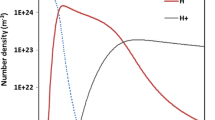Abstract
Several pure metal oxide particles, including iron oxide, manganese oxide, copper oxide and nickel oxide, were passed through a reducing plasma. The plasma was formed by injecting reducing gases, such as carbon monoxide or hydrogen, into a carbon arc. After passing through the plasma, the particles were quenched in water. The internal structure and surface morphology of the plasma-treated particles were studied using optical and scanning electron microscopy. The factors controlling plasma arc stability during particulate processing were also examined.
Similar content being viewed by others
References
G.K. Bhat, “New Developments in Plasma Arc Melting,” Journal of Vacuum Science and Technology, vol. 9 (1972), pp. 1344–1350.
S. Santen, Plasma Smelting, Proceedings of the 6th International Symposium on Plasma Chemistry ISPC-6, Montreal, Quebec (1983), pp. 174–174c.
M.L. Thorpe and P.H. Wilks, “Electric Arc Furnace Turns Zircon Sand to Zirconia,” Chemical Engineering (November 15, 1971), pp. 117–119.
M.G. Fey, “Industrial Plasma for Iron and Steelmaking,” Electric Furnace Proceedings, vol. 40 (1982), pp. 239–248.
S. Santen, “Plasma Technology Gives New Lease on Life to Swedish DR Plant,” Iron and Steel International, vol. 52, no. 6 (1979), pp. 347, 349.
W. Borchers, Electric Smelting and Refining, Charles Griffin and Co. Ltd. (1987), p. 131.
J.J. Moore and K.J. Reid, “The Potential for Direct Reduction of Iron Ore in a Sustained Shockwave Plasma Reactor,” Electric Furnace Conference Proceedings, ISS-AIME, vol. 40 (1982), pp. 231–238.
J.K. Tylko, J.J. Moore and K.J. Reid, “Reduction of Lean Chromite Ore Using a New Type Plasma Reactor,” Extractive Metallurgy of Refractory Metals Symposium, TMS (1981), pp. 377–417.
C.A. Pickles and A. McLean, “Production of Fused Refractory Oxide Spheres and Ultrafine Oxide Particles in an Extended Arc,” Ceramic Bulletin, vol. 62, no. 9 (1983), pp. 1004–1009.
M.N. Saha, Phil. Mag., vol. 40 (1920), p. 472.
H. Ayrton, The Electric Arc, the Electrician Series, D. Van Nostrand Inc. (1902), p. 290.
A. V. Engel and M. Steenbeck, Wiss. Veroff. a.d. Siemenskonzern, vol. 12, Part 1 (1933), p. 74.
Additional information
Chris Pickles received his Ph.D. in metallurgical engineering from the University of Toronto in 1977. He is currently an associate professor in the Department of Metallurgical Engineering at Queen’s University in Kingston, Ontario, Dr. Pickles is also a member of TMS.
Rights and permissions
About this article
Cite this article
Pickles, C.A. In-Flight Plasma Reduction of Metal Oxides. JOM 40, 31–35 (1988). https://doi.org/10.1007/BF03258791
Published:
Issue Date:
DOI: https://doi.org/10.1007/BF03258791




